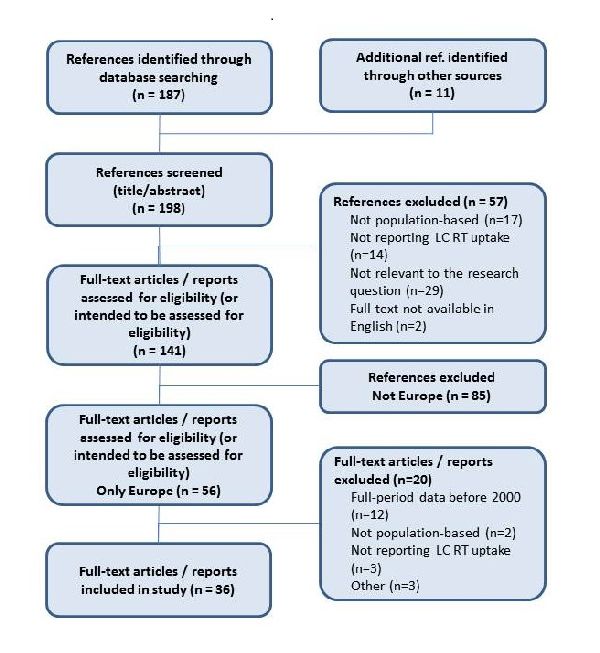A total of 198 references were identified (11 additional references were identified through other sources). After applying the exclusion criteria, a total of 141 studies were assessed for eligibility, in which only 56 studies were European-based articles. Finally, after applying the exclusion criteria, a total of 36 studies were included in this review (Figure 1).
A 69% (n=25) of the studies were conducted in the Netherlands (47%, n=17) and the United Kingdom (22%, n=8). This geographical dominance pertains to all study populations, with additional large reports on specific patient populations coming from the Nordic countries (e.g. Norway for overall LC, Sweden for NSCLC), Belgium (on NSCLC) and Germany (for stage I NSCLC).
A total of 14 studies reported the overall percentage of actual RT uptake, in different study populations. For NSCLC in general this hovers around 40%, meanwhile in stage I NSCLC, the uptake ranges between 30 and 50% depending on the time period studied. SBRT use was reported in 8 studies (5 in early-stage NSCLC, and 5 from the Netherlands). Although study populations slightly differ across studies, in the most recent periods, typically higher SBRT uptake is reported in the Netherlands (40-63%), followed by Norway (29%), and finally, Sweden (12-34%) and England (around 12%). A total of 14 studies reported on CRT use, mostly in stage III NSCLC, but also 2 pertaining to SCLC and 1 study to both. Again, the majority (71%, n=10) of data were from the Netherlands. For the most recent years, the Netherlands reported CRT uptake in around 40-48% of all patients diagnosed with both locally-advanced NSCLC and early-stage SCLC, whilst two studies carried out in England and Belgium reported a lower uptake of CRT in the population.
Figure 1. PRISMA flowchart
